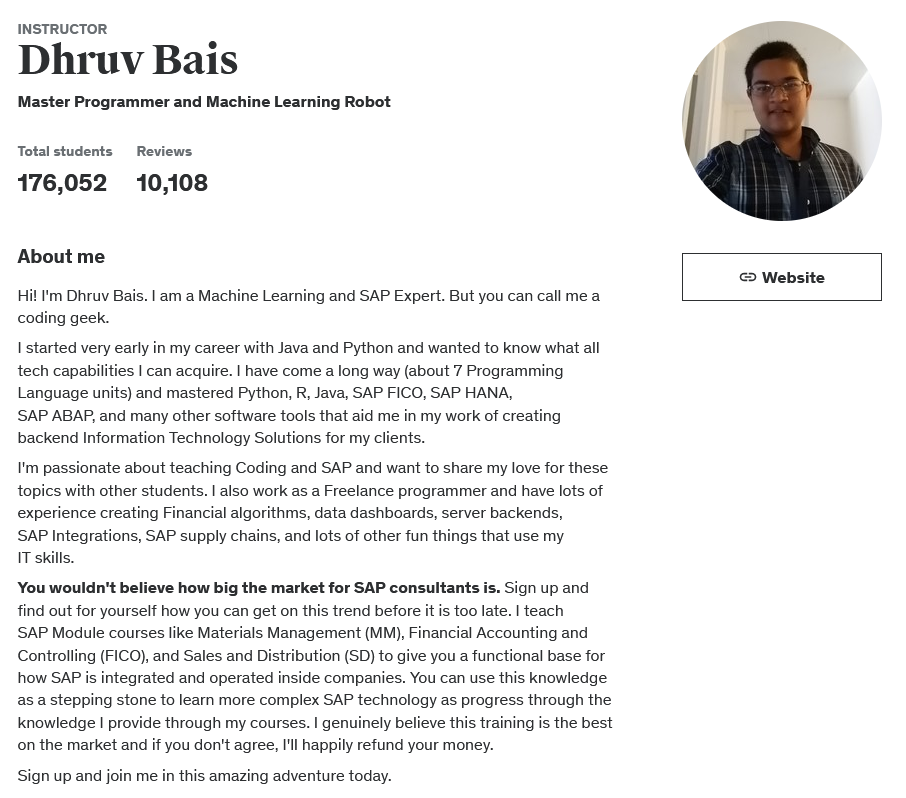Diving into the world of SAP, particularly its Financial Accounting (FICO) module, can feel like wading through alphabet soup. But if you’ve stumbled upon “SAP FICO For Beginners – A Guide to SAP Financial Accounts” by Dhruv Bais, you might just have found your spoon. Dhruv, a self-proclaimed Master Programmer and Machine Learning Robot, brings his extensive knowledge and a sprinkle of coding geekiness to the table, aiming to simplify the complex. Let’s break down this course and see if it’s the key to unlocking the SAP kingdom.
Instructor Reputation
When it comes to navigating the complex and often intimidating world of SAP FICO, having a knowledgeable and experienced guide can make all the difference. This is where Dhruv Bais shines as a beacon for beginners. With a solid 4.2 instructor rating, amassed from over 10,000 reviews, Dhruv’s credentials are not just numbers on a screen; they are a testament to his ability to demystify the intricacies of SAP for a broad audience.

His journey through the realms of coding began early, traversing through languages like Java and Python, and expanding into the specialized field of SAP, including FICO, HANA, and ABAP. This diverse expertise positions him uniquely as an instructor who can draw parallels between different aspects of programming and SAP, enriching his teaching with broader insights into the world of technology.
Dhruv’s approach to teaching goes beyond traditional lecturing. He identifies himself as a Master Programmer and Machine Learning Robot, blending the precision and depth of a machine with the approachability and passion of a human educator. His engagement with a staggering 176,052 students across 19 courses is a feat that speaks volumes about his reach and impact in the online learning community.
What sets Dhruv apart is not just his vast knowledge, but his genuine passion for teaching coding and SAP. He doesn’t just teach; he shares his love for these topics with students, a quality that makes learning from him not just educational but inspirational. Students often look for a mentor who can not only provide knowledge but also inspire them to explore and grow. Dhruv’s background as a freelance programmer and his extensive experience in creating backend solutions, financial algorithms, and SAP integrations add a layer of practicality to his courses. It’s one thing to learn from someone who knows the theory; it’s another to learn from someone who practices what they preach.
Course Structure
The “SAP FICO For Beginners – A Guide to SAP Financial Accounts” course is meticulously structured to cater to those who are new to the SAP ecosystem. Understanding the importance of building a strong foundation, Dhruv has designed the course to sequentially unfold the complexities of SAP FICO, ensuring that each concept is not only introduced but also reinforced through practical application. This step-by-step approach is crucial for learners who are navigating the SAP waters for the first time, providing a clear path through the forest of financial accounting and controlling modules.

At the outset, the course introduces learners to the basics of SAP FICO, laying down the groundwork for more advanced topics. This foundational approach is crucial, as it equips students with the essential knowledge and skills they will need to tackle the more complex functionalities of SAP FICO. Dhruv emphasizes the importance of learning by doing, a philosophy that permeates the entire course structure. Rather than overwhelming students with theoretical information, the course prioritizes immersion and hands-on exercises. This method is rooted in the belief that the most effective learning occurs not just through listening or reading but by applying knowledge in practical, real-world scenarios.
As students progress through the course, they are not only walked through the SAP FICO Installation process but are also introduced to key concepts such as data structures. Understanding how data is stored and managed is critical in the context of SAP, and Dhruv ensures that these concepts are made accessible to beginners. The course cleverly integrates information dissemination with practical exercises. A limited number of videos per section are dedicated to theoretical explanations, while the bulk of the learning material is presented through interactive exercises and real-life examples. This balance between theory and practice helps solidify understanding and encourages active engagement with the content.
Perhaps one of the course’s most distinctive features is its focus on problem-solving. Dhruv dedicates 2-3 lectures in each section to solving challenging exercises, guiding students through the process. This not only helps students grasp the syntax and programming of SAP FICO but also teaches them the crux of programming itself – the ability to solve problems programmatically and harness the power of SAP FICO. This problem-solving approach is invaluable, as it prepares students to think critically and apply their knowledge in various scenarios.
The course structure reflects Dhruv’s commitment to making learning a great and fun experience. He aims to empower students to progress through their path to learning advanced SAP, whether it involves delving into programming logic, backends, or engaging with more exciting aspects like Data Dictionaries. This commitment to providing a comprehensive and engaging learning experience is what sets this course apart and makes it a valuable resource for anyone looking to start their journey in SAP FICO.
Content Quality
The “SAP FICO For Beginners – A Guide to SAP Financial Accounts” course offers a content quality that stands out for its practical approach to learning the SAP FICO module. What distinguishes this course is its commitment to not only presenting information but ensuring that the information is digestible, relevant, and directly applicable to real-world scenarios. This practicality in content delivery is crucial for learners who are not just looking to memorize facts but to truly understand and apply SAP FICO in their professional lives.

One of the key strengths of the course’s content is its structured progression from fundamental concepts to more complex applications. The content is carefully curated to build upon each lesson, ensuring that learners have a solid grasp of earlier concepts before moving on to more advanced topics. This layered learning approach is particularly beneficial for beginners, who can easily get overwhelmed by the vastness and complexity of SAP FICO. By breaking down the content into manageable segments, Dhruv Bais facilitates a smoother learning curve.
Moreover, the course content is enriched with practical exercises and real-life case studies. These exercises are not mere afterthoughts but are integral to the learning experience, designed to reinforce the theoretical knowledge imparted in the lectures. Through these hands-on exercises, learners get to apply what they’ve learned in a controlled environment, allowing them to experiment, make mistakes, and learn from those mistakes in a safe space. This experiential learning component is critical in solidifying understanding and enhancing retention.
The course also does well in integrating SAP FICO’s technical aspects with its practical business applications. Learners are not just taught how to navigate the SAP system but are also given insights into how SAP FICO functions within the broader context of financial accounting and controlling. This holistic view is invaluable for learners looking to apply SAP FICO in their roles effectively.
However, the course is not without its limitations. As noted in some learner feedback, while the course starts strong, offering detailed explanations and engaging content, it tends to become more demo-like in later sections. This shift can leave learners craving more in-depth explanations and less focused on hands-on practice. Additionally, critical areas such as cost elements, cost objects, and profit centers are touched upon but not explored in depth, which could be a missed opportunity for learners to gain a more comprehensive understanding of SAP FICO.
Overall Course Rating – 8/10
Considering the course’s strengths and areas for improvement, I would rate “SAP FICO For Beginners – A Guide to SAP Financial Accounts” a solid 8 out of 10.

This rating reflects the course’s robust foundation in practical, hands-on learning and the instructor’s dedication to making SAP FICO accessible to beginners. The course’s structured approach, focusing on progressive learning and the integration of exercises, is commendable and aligns well with the needs of its target audience.
The rating also takes into account the high quality of the content and Dhruv Bais’s effective teaching methodology, which combines technical knowledge with engaging delivery. His passion for the subject and commitment to student learning shines through the course material, making it a compelling option for those new to SAP FICO.
However, the deduction in points is due to the feedback regarding the course’s tendency to skim over complex concepts in later sections and the lack of in-depth exploration in certain critical areas. Expanding the content to cover these gaps more comprehensively could enhance the learning experience and provide learners with a more rounded understanding of SAP FICO.
In summary, “SAP FICO For Beginners – A Guide to SAP Financial Accounts” is a strong entry point for anyone looking to delve into the world of SAP financial accounting and controlling. Its practical focus, combined with Dhruv Bais’s expertise and engaging teaching style, makes it a valuable resource for beginners. While there is room for improvement in deepening the exploration of certain topics, the course undoubtedly lays a solid foundation and sparks curiosity for further learning in the realm of SAP.



